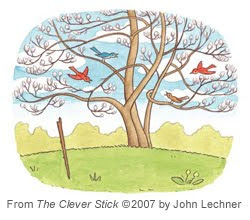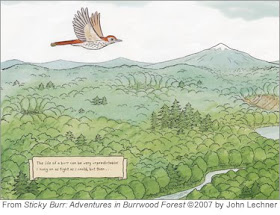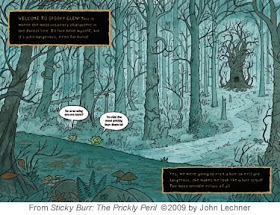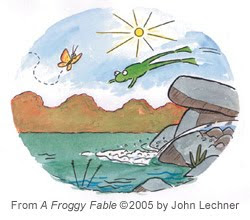 This month I'm celebrating John Lechner! He's here today to share some insights about being an author/illustrator, and he knows what he's talking about. John is a multitalented illustrator, author, animator, designer, puppeteer, and musician. He has four books to his credit so far, A FROGGY FABLE, THE CLEVER STICK, STICKY BURR: ADVENTURES IN BURRWOOD FOREST, and STICKY BURR: THE PRICKLY PERIL all published by Candlewick Press, as well as loads of great interactive material. Currently John is the art director at Peter H. Reynolds' children's media company, Fablevision. I'm very happy to feature John as April's Illustrator of the Month.
I assume people with great artistic talent always had it. Were you always good at drawing, even as a kid? When did you know you wanted to create children’s books?
This month I'm celebrating John Lechner! He's here today to share some insights about being an author/illustrator, and he knows what he's talking about. John is a multitalented illustrator, author, animator, designer, puppeteer, and musician. He has four books to his credit so far, A FROGGY FABLE, THE CLEVER STICK, STICKY BURR: ADVENTURES IN BURRWOOD FOREST, and STICKY BURR: THE PRICKLY PERIL all published by Candlewick Press, as well as loads of great interactive material. Currently John is the art director at Peter H. Reynolds' children's media company, Fablevision. I'm very happy to feature John as April's Illustrator of the Month.
I assume people with great artistic talent always had it. Were you always good at drawing, even as a kid? When did you know you wanted to create children’s books?
I’ve always loved to draw, and I was always encouraged as a child. I wrote and illustrated my first book in first grade, about explorers who fall into the ocean and escape from a whale. I always loved books and wanted to be an illustrator like those I admired (
Maurice Sendak,
N.C. Wyeth,
Bill Peet,
Arthur Rackham.) I studied art and creative writing in college, but didn’t really find my voice until much later.
 How did you develop your illustration style?
How did you develop your illustration style?
It just developed naturally over the years, it’s an odd mixture of naturalistic watercolors and simple line drawings. As I became more busy through the years, I drew faster and that helped to free up my style. I think it also comes from the things you draw, and since my stories often involve animals or nature, that also influences my style. I don’t like drawing buildings, I’m more at home in the forest.
 When both writing and illustrating a book, which comes first for you, the story or the art?
When both writing and illustrating a book, which comes first for you, the story or the art?

The words usually come first. I might draw a quick sketch to set the scene in my mind, but I usually write out the story as it comes into my head. When I get a story idea, I don’t think about whether it might be a book, I just write the story and see where it goes. Some ideas don’t go anywhere, but sometimes they end up better than you thought. If I think a story has potential, I might create a web version to try it out. That’s how
A Froggy Fable and
The Clever Stick got started.
 When submitting a book as the author/illustrator, do you complete the illustrations before submitting or do you submit a dummy?
When submitting a book as the author/illustrator, do you complete the illustrations before submitting or do you submit a dummy?
I usually submit a rough sketch dummy along with the typed manuscript. A picture book typically evolves a lot from the time it is accepted until the time you do the final illustrations. The publisher will want to consult with you on the text, the size of the book, the number of pages, and the layout. So illustrating the entire book beforehand is not practical.

The purpose of the sketch dummy is to convey your vision of the book, and give the publisher a rough idea of how it might read. But when your book is accepted by a publisher, their designer will likely make a new dummy with suggestions for making the layout stronger, just as your editor will make suggestions for strengthening the text. There is a lot of discussion and revision before the final layouts are ready and you can start the final illustrations.
 Your STICKY BURR books are part picture book, part comic book. What made you decide to go that route for these stories?
Your STICKY BURR books are part picture book, part comic book. What made you decide to go that route for these stories?
I originally envisioned the burrs as comic characters, because I wanted the stories to have a lot of action and visual humor. I started doing the
Sticky Burr web comic over ten years ago, which has evolved into the current version you see today. I envisioned the books as a combination of a comic and a picture book because I wanted them to be a little different. By inserting pages of Sticky Burr’s (or Scurvy Burr’s) journal throughout the comics, it not only allowed me to elaborate on the characters and their world, but it also provided a nice break in the story, making it easier to suggest the passing of time or changing of location, which otherwise would have been harder in such a short comic. I added the map and other things to help create an entire world for these characters.
 I have to ask. Why a burr?
I have to ask. Why a burr?
When I was young, my brothers and sisters and I would spend a lot of time in our backyard. It had squirrels, birds, dragonflies, grasshoppers -- a bit like Burrwood Forest. We also had bushes that grew burrs on them, and we always called them sticky burrs. It wasn’t until I was an adult, and thinking back to those years, that I thought the burrs would be great characters. I started writing stories about them, and they evolved into the world you see today.
Do you think it’s easier as both the author and illustrator of a book to get your story across?

Personally, I enjoy having control over the story and illustrations, because I tend to think of them together. I visualize the images in my head as I write. Though there are also advantages to working with someone else, as they often think of ideas that you didn’t.
You also create films and interactive games. Does this take a whole different skill set or does it complement your book writing and illustration work?

Like books,
films and interactive games also involve storytelling with images, but it’s really a different way of thinking. You’re thinking in real time, with real pacing. The storytelling techniques are different too. That’s why picture books that use still images from a film usually fall flat, because those images weren’t meant to stand alone, they were meant to be shown in connection with a thousand other images. So as an artist it can be challenging to shift from printed books to films and interactive stories, as you have to shift your brain into another way of thinking. But they all can inspire and influence each other.
Continuity of the looks of the character is so important. How do you achieve this page after page?
Continuity is very difficult, it takes a lot of erasing and comparing images side by side. However, you also don’t want to be too tied down to making your characters perfect, you also want them to be alive. Some of my favorite illustrators hardly have any continuity, yet they have so much life and energy in their art (
Ludwig Bemelmans is a perfect example.) Continuity of style is often more important than continuity of specific characters. As long as the world you create is consistent throughout, the characters will appear more consistent.
 If you use an additional illustrated story line in a book, do you decide on it purposefully or does it grow organically?
If you use an additional illustrated story line in a book, do you decide on it purposefully or does it grow organically?
It’s different with every book, but usually it happens in the illustration stage. For instance, in
Sticky Burr: The Prickly Peril, there are two burrs that both want to juggle, and one of them steals the juggling balls from the other. In the final page, they are seen juggling together. This is totally unrelated to the main storyline, yet it helps reinforce the malcontent of the burrs early on, and the camaraderie they feel at the end.
 What advice would you give to aspiring author/illustrators trying to break into the market today?
What advice would you give to aspiring author/illustrators trying to break into the market today?
It’s a very crowded field, but it’s also an evolving one because of new media and markets. Networking is one of the best ways to get connected with people in the field and get seen by an editor or art director.
SCBWI conferences are great, and there are so many writer conferences and comic conferences where you can meet people and learn from them. Keep an eye out for new small publishers, which are often more receptive to new authors. Don’t be afraid to try new things, such as ebooks or web comics. And never stop working and improving your art, try to work twice as hard as everyone else.
Want to tell us about what you’re working on right now?
I’m finishing up my first novel, which I hope will find its way to publication. I’m also drawing a weekly web comic about Sticky Burr and his continuing adventures. I also have a blog about art and nature called
The Untended Garden, where I write about how artists and writers are influenced by nature.

I’ve also been working on an interactive story, something that combines my interest in books, animation and interactive games. It’s a story without words, where the user advances the action, following a character as he journeys through a mysterious and deserted world. Although it’s interactive, it’s still a fairly linear story, with a beginning, middle and end. I’ve always been interested in the possibilities of interactive storytelling, and trying to push the boundaries of what can be done. I hope to unveil the project this spring.
You can learn more about John and see tons of his work at his website, http://www.johnlechner.com/ And check back this month for more from John!





















